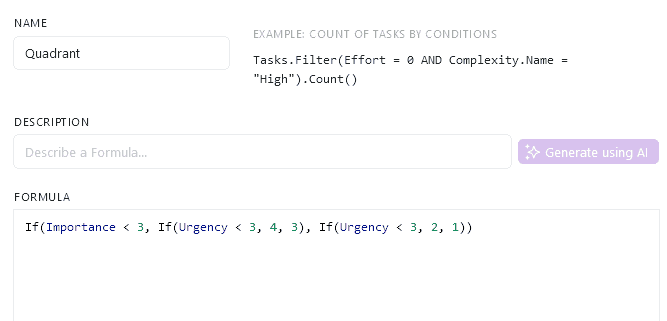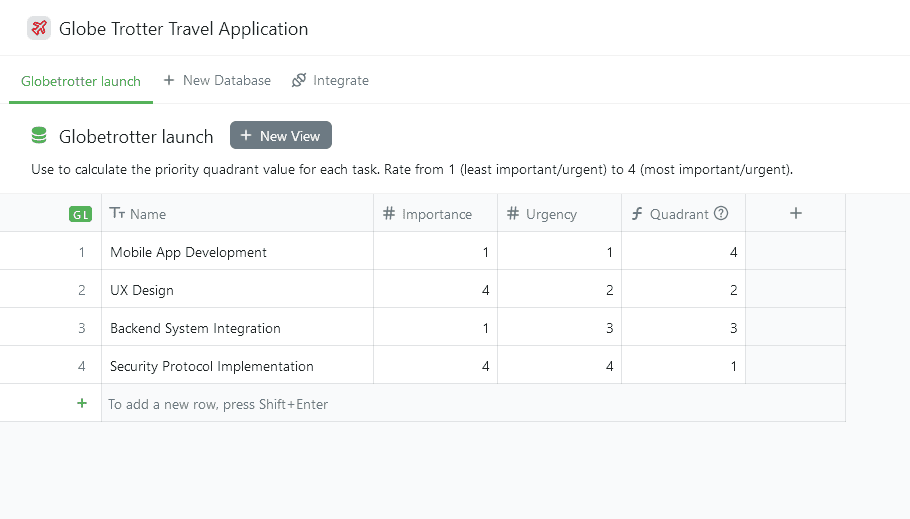The 2x2 Prioritization Matrix Explained
The 2x2 Prioritization Matrix is an essential construct for delineating and prioritizing tasks, offering teams a pragmatic lens in order to delegate their workload and effort.
By categorizing tasks along axes of urgency and importance, it allows visualization of priorities, ensuring a strategic alignment with key objectives.
This article will illuminate the matrix’s essence and its methodical assembly, providing clarity for those seeking to optimize their approach to product management in a landscape of competing demands.
What’s the 2x2 matrix exactly?
At its core, the 2x2 matrix serves as a structural guide to evaluate the myriad tasks confronting Product Managers. It’s a strategic tool derived from the Eisenhower Matrix, famously used by the 34th U.S. President for the minimization of delivery risk, and effective task management.
Its evolution into the 2x2 matrix presents a sophisticated, quadrant-based system that categorizes tasks by two critical dimensions:
- Urgency: How soon a task requires attention.
- Importance: The significance of a task in relation to long-term objectives.
This matrix breaks down as follows:
- Quadrant I: Urgent and Important - Tasks demanding immediate action.
- Quadrant II: Important, but Not Urgent - Strategic tasks that contribute to long-term product goals.
- Quadrant III: Urgent but Less Important - Tasks that are time-sensitive yet may not significantly impact overall strategy.
- Quadrant IV: Neither Urgent Nor Important - Low-priority tasks that often lead to busy work.

Understanding this categorization is vital for prioritizing product backlog effectively, especially when faced with a flood of potential initiatives.
It provides a clear methodology to sift through the noise, ensuring that teams focus on tasks that are critical to their product roadmap while avoiding the potential risks of misallocated attention.
How to build the 2x2 matrix?
In this example, we’ll be constructing a 2x2 Prioritization Matrix within Fibery for a travel platform project aptly named “GlobeTrotter.
It will involve organizing an array of tasks by their urgency and importance. This methodical approach enables Product Managers to allocate resources judiciously and adhere to critical timelines. Here’s how to develop this prioritization framework:
Step 1: Compile tasks
Begin with listing all pivotal tasks for the successful launch of “GlobeTrotter.” Tasks might include:
- User Experience (UX) Design
- Backend System Integration
- Security Protocol Implementation
- Feature Set Development
- Mobile App Development
- Partnership Acquisitions
- Legal Compliance
- Marketing and Public Relations Campaigns
- Customer Support Training
- Localization of Content
Step 2: Evaluate urgency and importance
Evaluate each task for its urgency, the potential time frame, and its importance, which will indicate its impact on the platform’s success.
In this Fibery example, each metric can be assigned a value related to its importance and urgency of 1 to 4. (least to most urgent/important).
For instance:
- UX Design: Very Important (4) but not Urgent (2)
- Backend System Integration: Urgent (3) but Not Important (1)
- Security Protocol Implementation: Very Urgent (4) and Very Important (4)
- Mobile App Development: Not Important (1) and Not Very Urgent (1)
Step 3: Create the matrix
In Fibery, set up a workspace dedicated to “GlobeTrotter.” Create an entity type titled ‘Tasks’ and add attributes for ‘Urgency’ and ‘Importance.’ Then, create a formula to automatically calculate which quadrant each task should belong to.


Step 4: Map tasks to quadrants

A Quadrant will be assigned to each task in Fibery:
- Quadrant I (urgent and important): Security Protocol Implementation
- Quadrant II (important, but not urgent): UX Design
- Quadrant III (urgent, but less important): Backend System Integration
- Quadrant IV (neither urgent nor important): Mobile App Development
Step 5: Prioritize based on quadrants
Direct immediate action towards Quadrant I tasks as they are critical for the platform’s operational integrity and security. Develop a strategic time frame for Quadrant II tasks, focusing on creating a robust and user-friendly product.
Address Quadrant III tasks promptly to ensure smooth operations at launch. Reassess and schedule Quadrant IV tasks; these are necessary but not immediately impactful.
Step 6: Review and adjust
Regularly revisit the matrix to ensure priorities align with the evolving landscape of the “GlobeTrotter” project. Agile reassessment allows for swift adaptation to new information or market demands.
Upon completion, “GlobeTrotter’s” 2x2 Prioritization Matrix will emerge as a clear, strategic layout of tasks, establishing a product roadmap for the team to follow from development to launch.
It’s not just a static chart but a dynamic framework that adapts to the project’s progress, ensuring that the team effort is concentrated where it’s needed the most.
Is the 2x2 prioritization matrix the right technique for me?
The 2x2 Prioritization Matrix is a strategic framework that aids product managers in navigating complex product roadmaps, especially when resources are finite.
It excels by clarifying which tasks require immediate attention and which will drive the project towards its long-term vision. Let’s look at some pros and cons of this approach for effort prioritization for product managers.
Pros
-
Enhanced focus on high-impact tasks: The matrix helps identify tasks that significantly advance product goals. For example, a PM at a tech startup may use the matrix to prioritize developing a core feature over less critical enhancements, ensuring the team focuses on what truly adds value for an imminent funding round.
-
Resource optimization: It enables efficient allocation of time and manpower. Consider a scenario where a PM has to decide between refining the user interface or scaling the backend infrastructure. The matrix could reveal that scaling the infrastructure is both urgent and important due to the upcoming user load, thus directing resources where they are most needed.
Cons
- Potential for oversimplification: The matrix’s binary nature might lead to oversimplifying complex decisions. A travel platform, for instance, might prioritize urgent bug fixes (Quadrant I) over exploring new revenue streams through innovative product features (Quadrant II), which could be vital for long-term growth but don’t seem urgent in the short term.
- Innovation neglect: By focusing on urgency and importance, there’s a risk of sidelining innovative tasks that don’t fit into the immediate framework of the matrix. This can lead to overlooking potential risks associated with ignoring market trends. For example, a PM might deprioritize exploring AI-based recommendations for users, a non-urgent yet potentially market-disrupting feature, in favor of more immediate, less impactful tasks.
The matrix should be considered a component of a broader strategic toolkit. It provides structure but requires integration with other decision-making tools to capture the full spectrum of a project’s needs and opportunities.
This ensures that while the pressing matters are handled, innovation and long-term value creation are not eclipsed in the pursuit of addressing the urgent and important.
The PM’s hot take
Employing a prioritization matrix is like using a spotlight in a dark room. It helps you focus on what’s crucial, not necessarily on what’s right in front of you.
Final thoughts
The 2x2 Prioritization Matrix is more than a tool; it’s a mindset shift, offering a clearer path through the complexities of product management.
It’s particularly effective in refining the product backlog, ensuring that urgent bug fixes and innovative feature explorations are appropriately balanced, and the matrix’s structured approach ensures that your strategic vision remains in focus.
Ready to harness the power of prioritized, impactful task management?
Dive deeper into the art of prioritization and explore how Fibery’s flexible platform can transform your product management cycle. Sign up here.
Psst... Wanna try Fibery? 👀
Infinitely flexible product discovery & development platform.